Other Galaxies
What's covered here:
- How do astronomers distinguish galaxies from other fuzzy objects?
- What did Edwin Hubble do that made him so famous?
- What different types of galaxies are there?
Galaxies and Edwin Hubble
We know quite a bit about other galaxies by using information about the
Milky Way and applying it to them as well as using our own observations
of other galaxies to figure out what is going on out there. The reverse
is also true - characteristics of other galaxies can be applied to the
Milky Way. Remember, we have a hard time seeing various parts of our
own
galaxy, so checking out other galaxies gives us an idea about what
distant parts of our galaxy look like or what is probably happening in
those places.
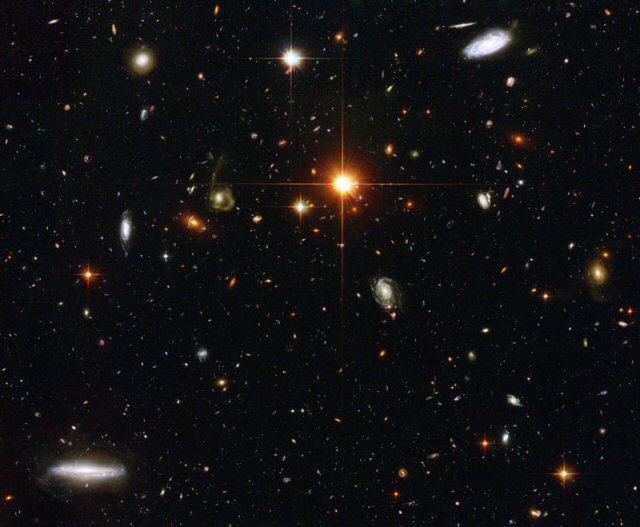
An image showing a wide array of galaxies. The "spikey" objects are stars in our
own galaxy. Can you tell which object is closer and which is further away?
Are you sure that all of the fuzzy objects are actually galaxies? Image credit:
NASA/ESA and the Hubble Heritage Team STScI/AURA
What do other galaxies look like? To the eye they are fuzzy patches in
the sky. With long exposures on film, various features such as spiral
structure and star clusters are visible. Though it is possible to see
trends in the general shapes of galaxies, they are all unique - sort of
like snowflakes.
But when you go to a telescope and look out in the sky and you see
these fuzzy things, how can you tell it is a galaxy? All little
bits of fuzz look sort of similar through a telescope, though there are
certain pattern to some of them. And just by looking at them with your
eyes through a telescope doesn't really help. Even the invention of
photography which helped astronomers get more detailed images of
galaxies, wasn't enough to tell them what these things were and how far
away they were. That was a major problem in astronomy around the
beginning of the 20th century. There were all of these fuzzy things out
there (which we called nebula, plural is nebulae) located all
over the place. But what were they? We thought some of them were in our
galaxy, but we were not sure which ones were and which ones weren't.
Perhaps none of the fuzzy things were outside of our galaxy? Perhaps
our galaxy is the only galaxy - who says there really are any other
objects out there any ways? Or perhaps our galaxy is just like one of
those fuzzy things - but like which type of fuzzy things? Does it have
a spiral shape like some of the spiral nebulae? Or an oval shape like
some of the nebula have? Or maybe some other kind of shape? According
to the best data at the time, we didn't really know where we were
located even in our own galaxy, so how was it possible to figure out
what those darn fuzzy things were?
This is really a conundrum. How will the astronomers be able to
solve this problem and save the day (well, at least solve this
problem)? They didn't really solve the problem at first. Initially
there was just a lot of talking about the problem and trying to show
who was right, who was wrong, and who had the worst breath. One of the
big discussions about the whole nebula problem took place in Washington
D.C. in 1920 at the National Academy of Science. The two people
involved in the debate were Heber Curtis and Harlow Shapley, so this
debate is known as the Curtis-Shapley
Debate. Now you've already run into Harlow Shapley, who was the fellow
that figured out the distance to the center of our galaxy back in 1915,
but some people had their doubts about his work. The other fellow, Heber Curtis (1872-1942), studied
the
spiral nebulae quite a bit, so he was really the expert when it came to
those things. You have two guys - one an expert about the size of our
galaxy, the other an expert on the spiral nebulae - debating each other
about various things like what are those spiral nebulae? What is it
really like out there? Just how big are the spiral nebulae? How far
away are they? How big is our galaxy? What is the Universe like?
It's sort of a draw as to who won the debate. Since Shapley was an
expert on the Milky Way, he was able to put forth his idea about the
distance we are from the center - which was pretty big. This was
correct. (Shapley actually thought that the Milky Way was about 100 kpc
wide, which isn't really correct, but he was along the right track).
Then he proposed that since the Milky Way was so huge (at least, bigger
than anyone ever thought it could be), those spiral nebulae were
probably not very far away objects. After all, our galaxy is so huge -
or so he thought.
Curtis believed that the spiral nebulae were actually distant objects,
not part of our Milky Way, and not even very close to it. He also
thought that our galaxy is just like them in terms of size, shape and
structure. He was correct on those points. Then he put forth that the
Milky Way was not very large (he thought it was only about 10 kpc in
size, which is much too small), since it was not large enough to
contain
the spiral nebulae. He sort of missed that one.
In a way, since each of them was an expert in one aspect of the
problem, they each got one thing right. They didn't know that at the
time, since just debating about something doesn't help figure out what
the actual answer is. Shapley was generally considered the winner of
the
debate due to his charisma (imagine that, an astronomer with
charisma!). The debate really didn't solve the problem. What did solve
the problem was good, solid science, in this case when Edwin
Hubble provided real evidence for the distances to galaxies in
1924. Hubble had an advantage over Curtis and Shapley, since he had the
use of the new, big telescope on Mount Wilson in southern California.
At that time, the big scope
was the 100" (2.5 meter) telescope located there.
Hubble and the telescope operator, Milton
Humason used this telescope to find and analyze Cepheid stars
in
the Andromeda Galaxy (of course, at that time, it was still known as
the Andromeda Nebula). What good are Cepheids? - plenty good! If you
remember from the previous section, Cepheids are those Red/Super Giant stars
that pulsate and you can use them to determine distance. The longer the
period, the greater the average brightness (the Leavitt Law) so if you can find a
Cepheid with a period similar to one in our own galaxy, you can compare
their apparent magnitudes (how bright they look to your eye), and the
difference in brightness is directly related to their different
distances. If you can find a Cepheid in a galaxy, you can find the
distance to that galaxy. That is exactly what Hubble and Humason did.
By using the Cepheid Leavitt Law to determine the
distance to the Andromeda Galaxy (one of our closer neighbors), they
found that it was 900,000 light years away! This distance was much
greater than anyone even suspected, and this is one of the close ones!
Actually, they were a bit off - it is actually about 2,250,000 light years
away - our current distance estimate methods are a little bit better now.
Not only did Hubble figure out that those fuzzy spiral nebulae (like
Andromeda) were actually very distant, separate objects, he started a
whole new field of astronomy, the search for objects that could reveal
distances to remote galaxies. To find the distances to far away
galaxies, it is necessary to use objects whose brightnesses we know
fairly well (or some other property that is well defined) and also
objects that are bright enough to be seen at a great distance. Objects
that fit both these criteria are referred to as Standard Candles. That's just sort
of a cute nickname for bright, well behaved objects. What sort of
things are Standard Candles? Here are some examples of them -
- Cepheids - The best thing to use, very bright, fairly common,
reliable thanks to the Leavitt Law
- RR Lyrae - Like Cepheids, but not as useful, since not as
bright.
Generally used only for nearby galaxies
- Supernovae - very bright, pretty useful, but can be tricky since
there are two types of supernovae, and some can be rather abnormal
- Planetary Nebulae - these are pretty hot and produce a lot of UV
light, so they can be seen distinctly from other things in the galaxy;
pretty reliable as distance indicators
- Novae - pretty bright, but not all novae are alike, so not as
reliable for accurate distances
- OB stars - by looking at the brightest stars you can sometimes
get good distances, but these are only in certain types of galaxies and
are often in regions of star formation that have quite a bit of dust
- H II Regions - not so great, since they can have different sizes
- Globular Clusters - if you can't see individual stars, use a
whole cluster, but not too good, since clusters are not exactly alike -
different sizes, brightnesses
- Brightness of the entire galaxy - assuming that all galaxies have
the same brightness is not too good, since they come in a range of
brightnesses - often just the brightest galaxy in a group is used
- and other methods...
Once an astronomer can determine how far away a fuzzy blob in the sky
is using a Standard Candle, they'll know if the fuzzy blob is in our
galaxy (a few thousand parsecs away) or is a distant galaxy (millions
or
more parsecs away).
Astronomers are able to get distances for galaxies within about 1
billion light-years fairly reliably, but there tend to be greater and
greater uncertainties in the values for greater and greater distances.
If you were to look up all of the distances to even nearby galaxies
(like Andromeda or the Large Magellanic Cloud), you'd see a range of
values, not just one single value. For very distant galaxies (say, more
than 1 billion light years away) the distances that we derive are much
more imprecise and can always be improved. This is one of the reasons
that bigger and better telescopes are being built all of the time, to
measure more and better distances. We need to know how far away things
are so we can figure out what the Universe is like.
Galaxy Names
Before people knew that galaxies were separate objects outside our
Milky Way, many of the brighter or more prominent ones were cataloged in
with the groups of various fuzzy things in the sky, which includes
stuff like planetary nebulae, star forming regions, globular clusters
and other non-galaxy things. When you look at the names of some of these
objects today, you can see a galaxy listed right next to a globular
cluster or a planetary nebula. Later catalogs were compiled which tried
to include only galaxies or were put together by specialized telescope
surveys, so some names are really screwy. In general you'll only run
across galaxies that are listed in the common catalogs. There are of
course galaxies that have proper or cute names like Andromeda, the
Large Magellanic Cloud, the Antenna galaxies, etc., but these are
pretty rare. More often you'll see a name from one of the catalogs like
the following -
- Messier catalog (M1, M2, etc.),
which has listed for the Andromeda Galaxy M31. There are about 110
objects in this catalog.
- New General Catalog (NGC 1, NGC 2, etc.), which
all start with NGC, and in this catalog the Andromeda Galaxy is known
as NGC 224. There are nearly 8000 objects in this catalog.
- Index Catalog (IC 1, IC 2, etc.), sort of an
extension of the NGC catalog, and a galaxy in this system could be
called something as exotic as IC 3242. There are about 5500 objects in
this catalog.
From this little discussion, you can see how original and creative
astronomers can be with naming galaxies. Actually, with there being
thousands of galaxies visible to most large telescopes, giving them all
individual names like "Bob" and "Becky" would be a bit too difficult.
You must remember that the catalogs mentioned above are just the more
commonly used ones, and these catalogs include a lot of non-galaxy
objects. The Andromeda Galaxy is so commonly surveyed and studied that
it has more than 20 different catalog names or designations - talk about
overkill!
Galaxy Characteristics
Once it was determined that many of those fuzzy things were actually
quite distant galaxies, astronomers had to classify them. Why? We are
sort of compulsive about doing things like this, but really it is because we could learn
more about them if we could group them together in a way that was
scientifically meaningful. This is sort of like how we can group stars
into bins like Main Sequence, Red Giant, and so forth. We know that
objects in such groups share common characteristics, and we can use
that
information to learn more about galaxies that we don't see very well or
that are too distant to measure all of their characteristics with much
certainty.
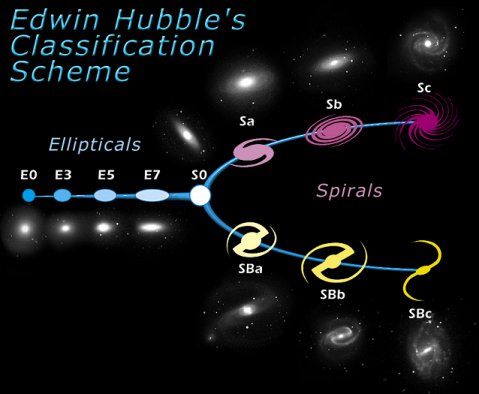 Figure
1. The Hubble Tuning fork diagram showing the different forms that
galaxies come in. The main groups are the ellipticals, the spirals and
the barred spirals. A transitional form is the Lenticular type (labeled
S0). Anything that can't be placed on the Tuning fork due to unusual
structures is simply labeled as Irregular.
Figure
1. The Hubble Tuning fork diagram showing the different forms that
galaxies come in. The main groups are the ellipticals, the spirals and
the barred spirals. A transitional form is the Lenticular type (labeled
S0). Anything that can't be placed on the Tuning fork due to unusual
structures is simply labeled as Irregular.
What do they look like? Do they all look the same? No, of course not;
that would be too easy. Most often we classify galaxies based upon
their
appearance, since that is the most easily observed feature. The basic
classification scheme that is used is known as the Hubble Tuning Fork Diagram (I wonder
what clever astronomer thought that up). Yes, good old Eddy Hubble set
down the framework for the primary classification scheme. There are
some other schemes used, and there have been slight alterations to the
guidelines that Hubble used, but it is pretty much still the same thing
used today. It should be noted that this scheme is based only on
appearance - the shapes of galaxies. It doesn't account for how they
got into those shapes or the differences in sizes that exist.
Not only do the galaxy shapes vary, but also the content of the
galaxies varies - different types of galaxies can have quite different
types of stars in them and different environments. This can result in
galaxies having different colors, different things happening (or not
happening) in them, different ages, different evolutions, and so on.
Remember the different stellar populations -
- Population I - hot, young stars present, which are chemically
like the Sun; their presence indicates that current star formation is
going on
- Population II - old stars dominate, metal deficient
compositions,
no new or significant star formation currently occurring
Remember, galaxies are very far away, so you generally can't see
individual stars, but you can see large groups of stars. That is why we
talk about stellar populations, since the characteristics of groups of stars is
what we are able to measure. Let's start checking out the different
types of galaxies that are out there.
Ellipticals

Figure 2. Several different elliptical galaxies are shown.
Copyright Association of Universities for Research in Astronomy Inc.
(AURA), all rights reserved.
As the name implies, these are elliptical in shape, though some are
not very elliptical at all but look like circles. To distinguish the different
shapes we use a numerical designation along the lines of E0, E1,
E2...all the way up to E7. The "E" is for elliptical, while the number
describes the degree of ovalness. The number is found by measuring the
long (a) and the short (b) axis, and taking those values and putting
them into the following formula
10(a-b)/a
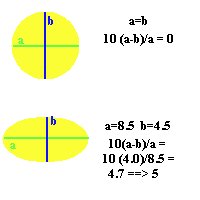 Figure 3.
The method used for defining the
different
elliptical galaxies is illustrated here. The longer axis length is
compared to the shorter length and a number based upon this value is
used to distinguish the range of elongation. In the first case both
axes are the same length so the type is E0, while in second the value
of 4.7 is found using the formula, which becomes 5, making that
elliptical an E5.
Figure 3.
The method used for defining the
different
elliptical galaxies is illustrated here. The longer axis length is
compared to the shorter length and a number based upon this value is
used to distinguish the range of elongation. In the first case both
axes are the same length so the type is E0, while in second the value
of 4.7 is found using the formula, which becomes 5, making that
elliptical an E5.
Ellipticals tend to look rather yellowish or orangish. This
indicates that they are made up of mainly Population II stars.
Observations of them show that there is no new (or significant) star
formation occurring. There is not much star formation occurring, which
means that there must not be a lot of gas and dust in them, since this
is what stars are made from. This also gives us a clue concerning how
they were made - but I'll get to that later. If you were to look at how
the stars in elliptical galaxies move, you'd tend to see rather random
motions (sort of how globular clusters move around our galaxy).
 Figure 4. A
group of galaxies with a large cD (Giant Elliptical) in the center of
the group. Image from the Hubble Space Telescope.
Figure 4. A
group of galaxies with a large cD (Giant Elliptical) in the center of
the group. Image from the Hubble Space Telescope.
The biggest of the ellipticals are often just called Giant Ellipticals and these are the
largest of all galaxies. They get a special designation rather than the
E designation; they are labeled as cD
galaxies - don't ask me why they're called that, they just are. These
tend to be very spherical in shape, so I guess they don't need the "E"
designation scheme - but there are other features that make them
distinct. They can have masses of up to 10 trillion solar masses (1013
Msolar). They are so big that they tend to be found in the
center of groups or clusters of galaxies. It is likely that these big
brutes weren't always that big but have gotten bigger over time by
eating up little galaxies that got too close to them (what we call Galactic Cannibalism- really, we do).
On the other end of the scale, one finds the Dwarf Ellipticals
and Dwarf Spheroidals.
These are among
the smallest of all galaxies, typically with masses around a few
million solar masses (106 Msolar). Dwarf
Ellipticals and Spheroidals can be best described as galaxy groupies, since they tend
to hang around much larger galaxies. If you look at a picture of the
Andromeda Galaxy, you'll see two little dwarf galaxies (one is an elliptical
the other spheroidal) around it. Due to their wide range of masses,
ellipticals are sort of hard to figure out. Sometimes it is hard to
determine if you are looking at a nearby dwarf elliptical or a distant
larger elliptical.
Spirals

Figure 5. Several different spiral galaxies. Copyright
Association of Universities for Research in Astronomy Inc. (AURA), all
rights reserved.
Spirals
show a much greater range of structure than ellipticals,
so their classification is a bit more complex. First there is the
letter "S" designating the galaxy as a spiral. Then there are the cases
where there is a Bar going
through the center of the galaxy. If so, you need to add a "B" to the
designation. Then there are the other characteristics - how big the
bulge is compared to the entire galaxy, and how tightly wound up the
arms are. There is a tendency that when the bulge is large the arms are
wound up pretty tightly, and when the bulge is really small the arms
are
really spread out. The letters a, b, c and d are used to categorize
this characteristic. The various designations for spirals are Sa, Sb,
Sc, Sd, SBa, SBb, SBc and SBd. Some people are a bit indecisive about a
galaxy being in a particular group, so sometimes a spiral can be
designated as a Sab or Sbc, since they're not sure which group it
belongs in.
Spirals are easy to identify since they have a spiral structure or flat
disk shape (if seen edge on). Of course, they have the spiral arms due
to the star formation that is occurring there, but remember, there is
material between the arms; it is just not as exciting or as easy to see as
the arms. The arms stand out so well because they have all of those
hot, big stars to light them up as well as the H II regions in the area. The
masses of spirals are typically a few billions to a trillion solar
masses. There is the added complication that they aren't made of
the same stellar populations. The populations of stars vary depending
upon where you are looking - in the disk you find Population I stars
and in the bulge and halo you find Population II. This is why in color
pictures of some spirals you see the disk looking bluish while the
bulge looks yellowish-orangish.

Figure 6. Classic examples of Barred spirals. Copyright
Association of Universities for Research in Astronomy Inc. (AURA), all
rights reserved.
Barred Spirals share pretty
much the same characteristics as spirals except for that extended
bulge. It is sort of like someone has taken the normally circular bulge
shape and stretched it out. The arms then start up on the ends of the
bar. Due to this added structure, the arms in barred spirals tend to be
wound up a little bit more tightly than in regular spirals. It is now
thought that the Milky Way Galaxy is a barred spiral; perhaps it could be
classified as a SBb or maybe even an SBc.
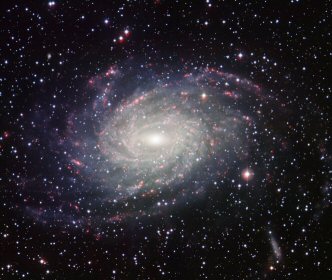 Figure 7.
A barred spiral, NGC 6744. It is possible that this is what our Milky
Way galaxy looks like. Notice how the arms are not very distinct and
poorly defined. It is also thought that the Milky Way galaxy has a bar
similar to this one. Image credit: ESO.
Figure 7.
A barred spiral, NGC 6744. It is possible that this is what our Milky
Way galaxy looks like. Notice how the arms are not very distinct and
poorly defined. It is also thought that the Milky Way galaxy has a bar
similar to this one. Image credit: ESO.
Lenticular Galaxies
S0 and SB0 types, also known as Lenticular Galaxies, are sort of
crosses between a spiral and and elliptical. They are best described as
having a flying saucer shape, since they have a disk and a bulge like a
spiral galaxy but no spiral arms. The bulge is often pretty big! They
don't have any spiral structure, so they don't have much star formation
going on (remember, that's why we have spiral structure). The lack of
star formation indicates a lack of gas and dust out of which to make
stars. Thus, S0 galaxies have mainly Population II stars in them. If
they have a bar, then the SB0 designation is used (make sure you don't
get the letters out of order for this designation!) In general S0
galaxies are pretty rare.
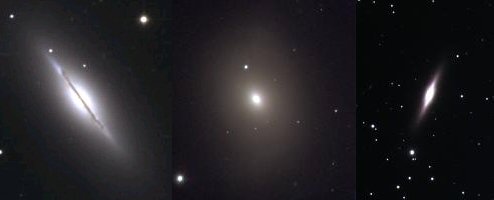
Figure 8. Lenticular
(or S0) galaxies. These look like a cross between an elliptical and a
spiral. You might think of them as a type of spiral galaxy without any
spiral structure. The one on the left has a dusty plane, but that is
unusual for these galaxies. The one on the right is in the same
orientation but shows no dusty structure. Copyright Association of
Universities for Research in Astronomy Inc. (AURA), all rights reserved.
Irregulars
As with any classification system, there have to be a bunch of objects
that don't fit in. For galaxies, these are the Irregulars. Amongst the more famous
irregular galaxies are the two neighboring galaxies to the Milky Way,
the Large and Small Magellanic Clouds (LMC and SMC). They sort of have a bar-like
structure, but there isn't anything else there - no spiral structure,
no defined bulge, nothing.

Figure 9. Some typical irregular galaxies. The
Large Magellanic Cloud is in the middle, and the Small Magellanic Cloud
is on the right. Copyright Association of Universities for
Research in Astronomy Inc. (AURA), all rights reserved.
It is thought that if there was some structure to an irregular
galaxy at some time, like spiral arms or bars, then those parts of the
galaxy could have been stripped off due to collisions or other
gravitational interactions with larger galaxies. Galaxies don't have to
actually get too close for there to be tidal disruptions of the
galactic structure. As previously mentioned, it is possible for one
large galaxy to strip off the gas and dust from a small, nearby galaxy
and to suck it up. The bigger galaxy is basically eating away the star
forming material (gas and dust) from its hapless victim. This is known
as Galactic Cannibalism (and is best served with fava beans and a nice
chianti). Irregular galaxies tend to be associated with rather
tumultuous events, so they tend to have a lot of star formation going
on in them, but this isn't true for all of them, since there can be a
wide range of stellar populations (I and II) in different irregulars.
Generally, Population I is what is seen. Irregular galaxies form from
previously normal galaxies, so they tend to have a wide range of
masses. They're just irregular!
It is worth mentioning that the two irregular galaxies that are best
known are the LMC and SMC (Large and Small Magellanic Clouds). These are
not visible from Iowa, but only from fairly far south of the equator.
It is possible to see these two nearby galaxies with the naked eye. Since
they are so close, they have been studied very extensively - though you have
to go to Chile, Australia, or South Africa to study them at all. Because these
galaxies appear to be interacting with our own, and it is likely that the
Milky Way collided with them in the past, they show a great deal of star formation
currently going on.
New images showing the hot gas in these galaxies are visible, and can be seen here -
for the LMC and the SMC. Features
such as hot gas from star formation, novae and old supernovae is clearly visible.
The part of the galaxies that we tend to see with our eyes is generally much smaller.
Now that you've read this section, you should be able to answer these questions....
- What methods are used to determine the distances to galaxies?
- What is the general scheme that is used used to classify galaxies?
- What are the criteria used to classify elliptical galaxies?
- What are the criteria used to classify spiral galaxies?
- Why do irregular galaxies have no specific form?
 Figure
1. The Hubble Tuning fork diagram showing the different forms that
galaxies come in. The main groups are the ellipticals, the spirals and
the barred spirals. A transitional form is the Lenticular type (labeled
S0). Anything that can't be placed on the Tuning fork due to unusual
structures is simply labeled as Irregular.
Figure
1. The Hubble Tuning fork diagram showing the different forms that
galaxies come in. The main groups are the ellipticals, the spirals and
the barred spirals. A transitional form is the Lenticular type (labeled
S0). Anything that can't be placed on the Tuning fork due to unusual
structures is simply labeled as Irregular. 

 Figure 3.
Figure 3.
 Figure 4. A
group of galaxies with a large cD (Giant Elliptical) in the center of
the group. Image from the Hubble Space Telescope.
Figure 4. A
group of galaxies with a large cD (Giant Elliptical) in the center of
the group. Image from the Hubble Space Telescope. 

 Figure 7.
A barred spiral, NGC 6744. It is possible that this is what our Milky
Way galaxy looks like. Notice how the arms are not very distinct and
poorly defined. It is also thought that the Milky Way galaxy has a bar
similar to this one. Image credit: ESO.
Figure 7.
A barred spiral, NGC 6744. It is possible that this is what our Milky
Way galaxy looks like. Notice how the arms are not very distinct and
poorly defined. It is also thought that the Milky Way galaxy has a bar
similar to this one. Image credit: ESO. 
